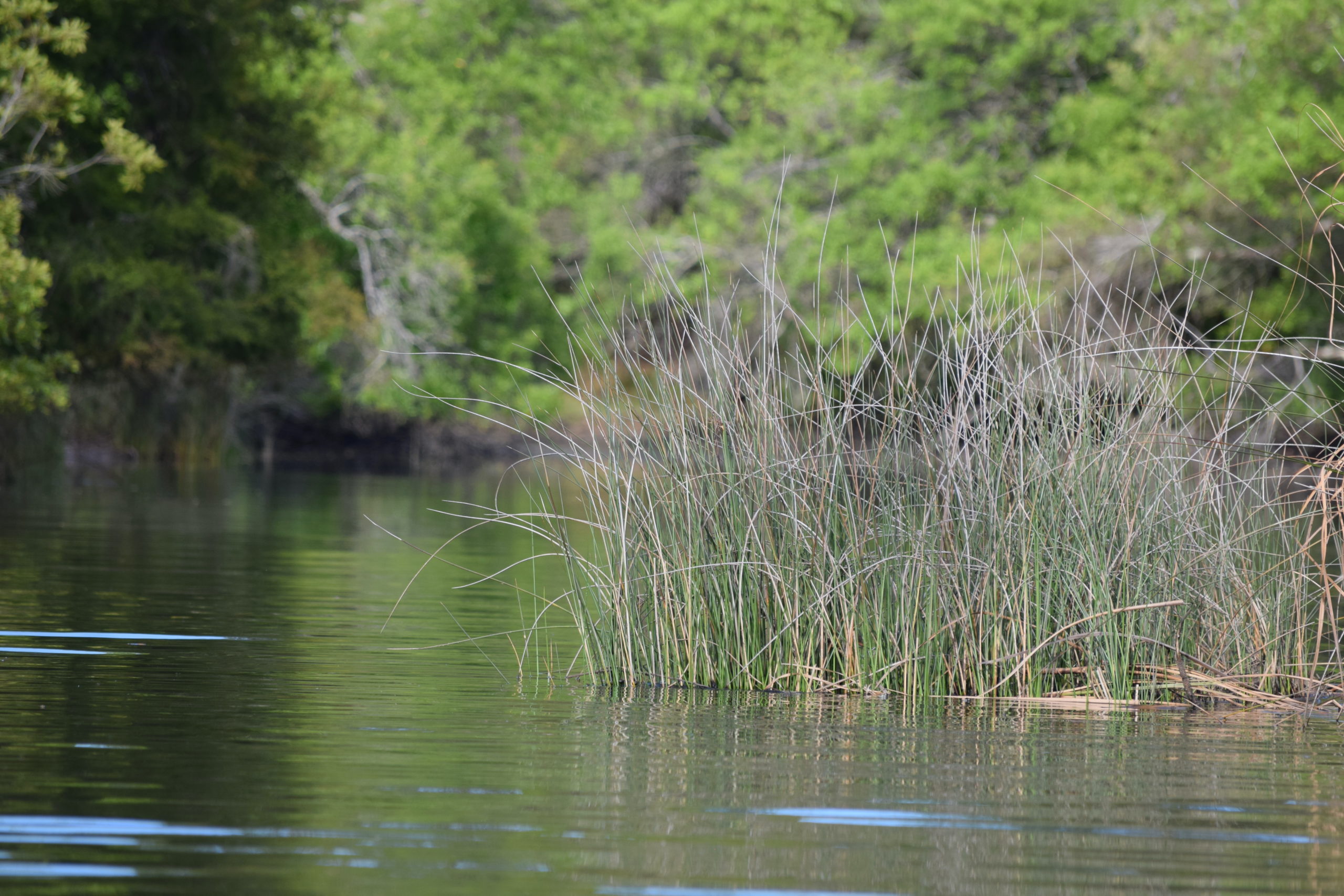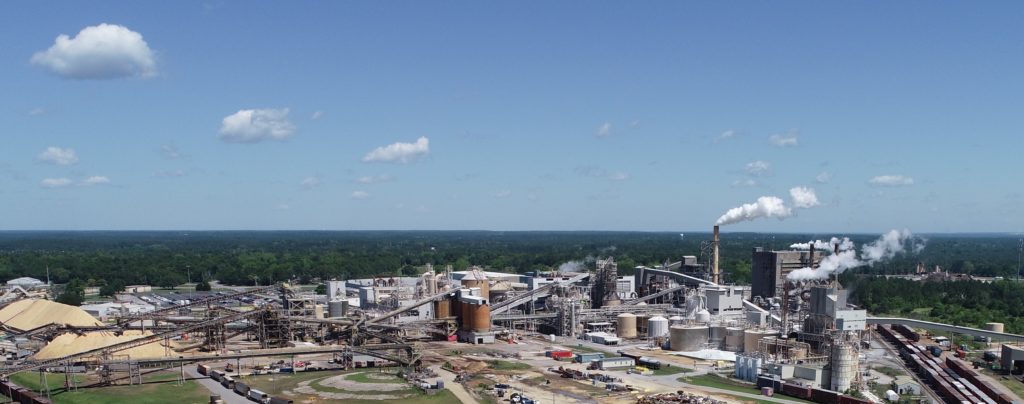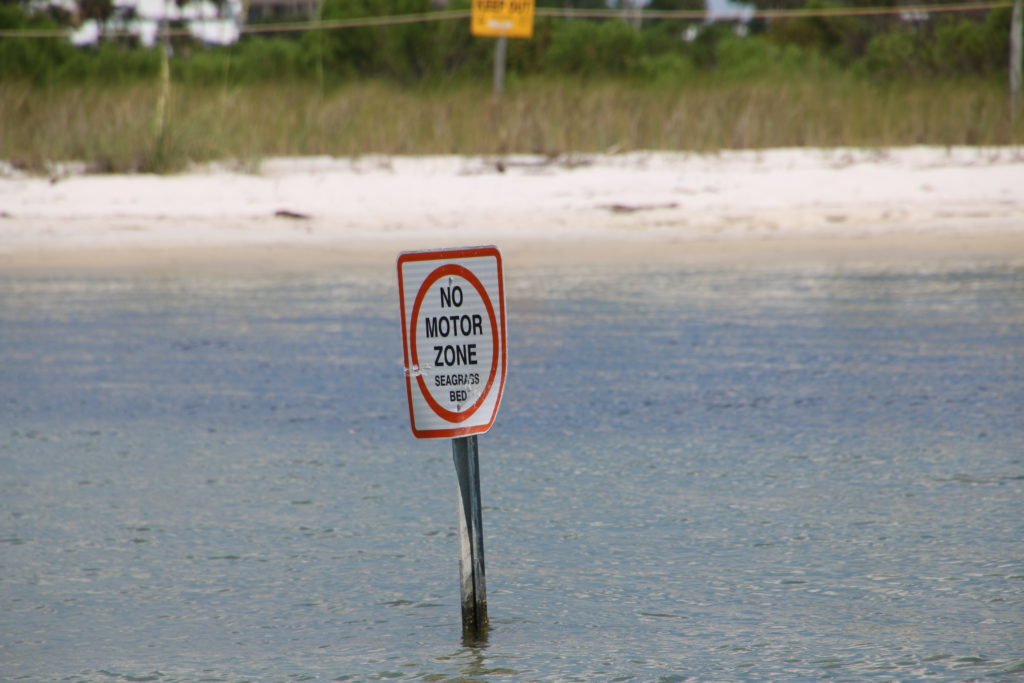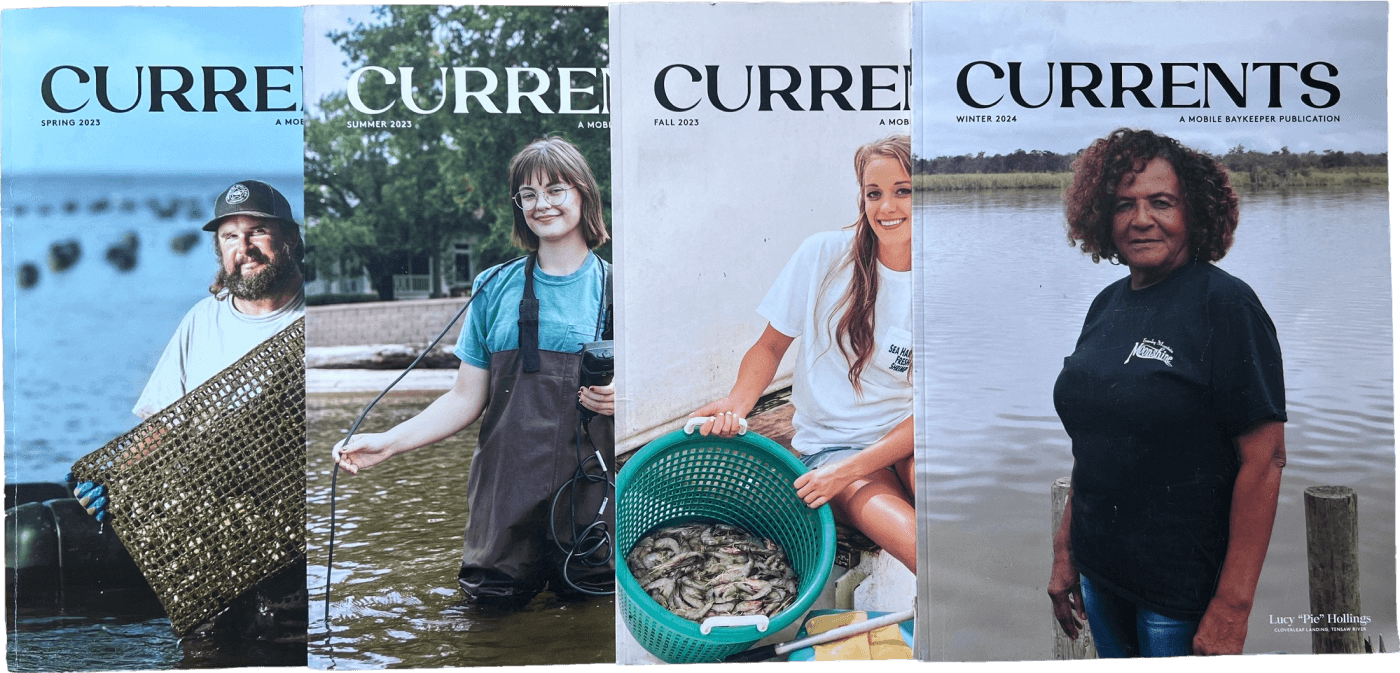
This article is from the fall 2024 edition of Mobile Baykeeper’s print quarterly, CURRENTS. The magazine is mailed to active members who have given more than $50 in the past year. To get on the magazine’s mailing list, donate here.
by Caine O’Rear
Sitting on the edge of Soldier Creek, staring across the water of a fine April morning. The wildflowers are in bloom, little purple clusters that my dog won’t stop eating. The tide is low at this hour and the weather is cool. There are few signs of life in the water below the wharf. I have never caught many fish here, other than catfish, a perennial nuisance. Once in a while I’ll catch a redfish or sheepshead, or maybe some white trout off the artificial reefs in Perdido Bay — but for the most part, it’s about the act, not the catch, when you work with rod and reel in these parts.
If you talk to the old-timers around here, they will tell you the fishing is not what it used to be. If you ask why, most will point the finger at the paper mill in Cantonment. From the 1940s until 2012, the mill – which came under the ownership of International Paper in 2000 – discharged the bulk of its liquid waste directly into the waters of Eleven Mile Creek, a tributary of Perdido Bay, causing catastrophic levels of pollution.
“There was something they were dumping in the water that was keeping the sunlight from penetrating, and it was killing the grass beds,” says Captain Wes Rozier, a veteran in-shore fishing guide who grew up near the bay and started guiding in his teens. Rozier can remember the lush grass beds that covered the bay in the 1960s, back when crabs and oysters were plentiful.
“Until the grass grows back in Perdido Bay, the fishing is not going to be good here,” he says with some resignation. “And it used to be such a great fishery. The ducks were back there in the rivers. Oh man, it was really good.”
Today, International paper reroutes its waste through a pipeline that empties into 1,400 acres of sprawling wetlands. As part of a process that is designed to reduce pollution input, the waste percolates in the wetlands for several days before settling into Eleven Mile Creek. This newfangled system was set up back in 2012, in compliance with the 2010 National Pollutant Discharge Elimination program. “As it relates to further development of the wetlands, we have a dedicated team focused on ongoing preservation efforts and driving future investments toward maintaining the wetlands,” Whitney Fike, the regional communications manager for IP, tells Mobile Baykeeper.
While many consider IP’s efforts effective, skeptics remain.
“We haven’t really seen any difference in the bay since [2012],” says Jackie Lane, a marine scientist who’s run the environmental watchdog group Friends of Perdido Bay for nearly four decades. “The fishing didn’t really get any better. In fact, it’s continuously been getting worse. Lack of good algae is the problem. When you only have blue-green algae blooming off the bay, you’re not going to get a good food chain off of that.”
Lane casts some of the blame for the bay’s pollution on the EPA, for allowing chlorine dioxide to be used by the paper mills as a bleaching agent for its pulp products. “As we have seen on Perdido Bay, chlorine dioxide breaks down into chlorate which is a potent herbicide. This has upset the primary productivity in the bay,” Lane wrote this spring in her monthly newsletter.
It’s no secret the upper part of the bay has borne the brunt of the damage. You can sometimes see a brown-white scum that looks like dish detergent frothing along the upper bay’s shores. Some of the foam is natural, while some is augmented by pollution, but just how much is caused by pollution is hard to say.
The water around the Lillian Bridge offers telling signs as well. The bridge can be a popular location for catching sheepshead, especially in the late summer and early fall. Some fishermen tie off on the pilings and fish under the bridge, while others anchor close by. I have moored there many times but I doubt I’ll do it again. When you pull your anchor up from the murky depths, you inevitably find that it’s covered with a dark and gooey slime — what Lane calls a “dioxin-laden sludge.” The gunk is hard to wash off and makes a cruel mess of the boat. It looks like the sign of a waterbody that is sick and diseased; a far cry from the sandy bottoms that once blanketed the bay floor. I have never caught many fish under that bridge, but it is where some anglers go when they’re looking to land sheepshead for a fishing tournament, or entertain a guest with a sure catch.
Fortunately, Soldier Creek, where I spend most of my time, seems to have escaped the pollution issues that plague other parts of the watershed. Testing from Mobile Baykeeper’s SWIM program indicates consistently low levels of fecal bacteria there. The creek is a relatively protected estuary that flows nine miles from its source before emptying into the bay’s middle portion. Its headwaters consist of scenic hardwood swampland canopied by cypress, sweet bay, and swamp tupelo. Beyond it stretch moist pinelands and thick forests of pine-oak. As it flows south the creek becomes a saltwater marsh that is dotted with cordgrass, black needlerush, and other grasses, a critical habitat for aquatic life.
I still catch my share of blue crabs in the middle part of the creek, along with juvenile shrimp when the season is right. Not to mention finger-mullet, pinfish, and a miscellany of other bait fish with my casting net. I am a certified natural with the net (my one true angling skill), and the joy of catching chum in that contraption helps offset the disappointment that attends a consistently slack fishing line.
In late summer I can sometimes catch the bigger mullet when they’re running. It is during these months when the dolphin sightings increase. You can find them moving into the fresher water at dusk as they chase schools of fish and perform little arabesques on top of the water before diving back down in search of their catch. I have never landed enough mullet to justify a neighborhood fish-fry, but a man can dream. Our late neighbor, a farmer of German stock named Curtis Cassebaum, held one every summer. He’d fry up the fish after a big haul with his seine and serve them to friends and family with a grin the size of Buc-ee’s, along with armloads of sweet corn from his family farm.
There was another fisherman in the neighborhood who was always worth his salt, and he lived next-door. His name was Jensen. He could work a bait net like a ninja. He knew every nook and cranny of the creek, as well as every honeyhole on Perdido Bay. He was a big-bear of a man with snow-white hair and a cigarette perpetually dangling from his chatterbox lips. I can still smell the cigarette smoke — Pall-Malls, I think they were — which hung thick and heavy on the wet air and announced his presence on those early summer mornings.
Like every good fisherman, Jensen was protective of his spots. When I first got to know him I urged him to take me out in his boat, but those pleas always fell on deaf ears. I knew he fished the reefs in the bay in the late fall with his brother and it was always gangbusters, to hear him tell it — hundreds and hundreds of white trout that he’d clean and freeze and send off with his brother when it was time for him to pack up and leave.
Jensen had lived on Soldier Creek for twenty or so years, long before my family’s arrival, and fishing was central to his life. Though I’m sure he did his share of deep-sea fishing, he was for the most part an in-shore fisherman, and he was committed to working the waters close to home, or in his own backyard, for that matter. One of the trademarks of his lifestyle was his mode of transportation on the home turf: the golf-cart. Every trip he ever made from his house to the wharf involved that little buggy. I don’t recall ever seeing him actually walk the one hundred and fifty feet on his own two legs.
I never spoke with Jensen about the health of the bay, and what it was like in the old days. Maybe it’s because I couldn’t get a word in between all his wisecracks. But he was not someone who was easily deterred by obstacles. He was going to fish till the end of his days regardless.
The Bay
Perdido Bay is shaped like a tilted hourglass, with its upper portion bisected by the Alabama-Florida state line. Its freshwater sources include Perdido River (which is rated an outstanding Florida water body for its ecological health), Eleven Mile Creek, and Bayou Marcus from the north, with Wolf Bay inputting into its southwestern portion. Palmetto Creek and Soldier Creek flow into its middle section on the western side.
It is a relatively small bay, covering just fifty square miles. The lower portion runs from Innerarity Point southward to Perdido Pass, where it flows across islands and shoals into the Gulf of Mexico. The bay’s watershed comprises Perdido Key in Florida, as well as Ono Island, Gulf Shores, Wolf Bay, Cotton Bayou, and Old River on the Alabama side, along with parts of the Gulf Intracoastal Waterway (GIWW).
For decades the bay has been beset by pollution, despite its status as a tourist destination. A grand jury investigation in the late 1990s revealed it to be one of the most polluted waterbodies on the Gulf Coast. In the fifty-two year period from 1940 to 1992, Perdido Bay lost seventy-four percent of its seagrass coverage, according to a 2002 report from the U.S. Geological Survey.

The Mill
Just north of Pensacola off U.S. 29 sits the town of Cantonment. The paper mill that defines the town to this day opened in 1941, when the region’s timber industry was in full tilt. The mill was built by a man named John Pace — for whom the town of Pace, Florida, is named — who ran a large-scale timber operation with his brother. Originally, the region’s forests were dominated by longleaf pine, but after timbering, the forests were replaced with faster-growing slash and loblolly pine to satisfy ever-increasing demand.
At the time of its opening, the Florida Pulp and Paper company owned and operated the plant, where it produced artillery boxes for the war effort. Today the mill is owned by International Paper, which purchased the operation from Champion International in 2000. The plant spans 900 acres with more than 500 employees. Headquartered in Memphis with more than 50,000 employees worldwide, International Paper is mostly owned by institutional investors like Vanguard, Blackrock, and State Street Global, with the top 11 investors owning 50 percent of the company. Its total economic impact is estimated to be in the neighborhood of $300 million, according to a 2019 report from the Pensacola New Journal.
For years, the general consensus has been that the mill is the main culprit of the bay’s pollution problems. Kenneth L. Heck, Jr., a local marine scientist, wrote the following in a 2005 report for the law firm Levin Papantino: “Since initial construction in the 1940s, and subsequent expansions of what is now the lnternational Paper Company’s mill in Cantonment, there have been a series of well-documented declines in water quality and environmental conditions in upper Perdido Bay that have been attributed to the discharges of IP and its predecessors, and reported in both the scientific literature and the popular press.”
The Good News
Despite years of pollution and ecological neglect, there are positive signs for Perdido Bay. According to satellite mapping data reports from 2020, there has been an increase of roughly 200 acres of seagrass in the bay since 2015.
That increase is due to several factors, according to Whitney Scheffel, a senior scientist at the Pensacola and Perdido Bays Estuary Program, a non-profit that was established from EPA grant funding in 2018. One of these is the presence of several no-motor zones around the islands in the lower part of the bay, which Scheffel calls “an effective way of protecting those grasses.”
The PPBEP has also been working with the Nature Conservancy on using dredge material to help restore areas like Robinson Island and Bird Island — popular hang-out spots for boaters and weekend revelers in the summer — and increasing seagrass habitat there.
“Those islands have seen a lot of erosion,” Scheffel says, “so we will be restoring the islands and transplanting some of the seagrasses to a safer location where the major beds occur. We hope to increase overall protection for those habitats to help bring it back to what it once was.”
In July, Mobile Baykeeper assisted with the transplantation of seagrass from Robinson Island to Walker Island.
Scheffel says a lack of historical data for Perdido Bay means we know less about water quality (e.g, dissolved oxygen levels, turbidity) in the Bay than the seagrass population. That means it can be hard to get a clear, comprehensive picture when it comes to assessing critical issues. The organization has been working with partners across different agencies to do more comprehensive monitoring. Watchdog groups like Friends of Perdido Bay have been conducting community monitoring projects through the years in certain sections of the bay. Scheffel says while those programs are good, more comprehensive efforts are needed.
“Sometimes you can get a silo and not really be thinking about it holistically,” Scheffel says. “Just to make those assessments you need a certain amount of data, and some of that data is just not there.”

I was curious to ask Scheffel about the sludge that blankets the bottom parts of the upper Bay; the slimy crud that invariably makes you question the health of your catch. (Last year the state of Alabama issued two fish consumption advisories for redfish and speckled trout caught north of the Lillian Bridge in Perdido Bay, recommending no more than two meals per month.) She says it’s likely the result of accumulation over time, stemming mostly from the days of heavy industrial pollution before the passage of the Clean Water Act. “I think it’s hard to determine one cause realistically,” she says of the sludge. “I think it’s the result of many decades of abuse.”
Scheffel notes that you encounter sandier substrate and less sludge as you move into the healthier, lower portions of the bay, which is to be expected as you move away from pollution point-sources. Yet she is careful to note that the yardstick by which one measures the bay’s health is ever-shifting.
“We’re kind of where we are and the environment is changing rapidly,” she says. “We will never get it back to what it once was and that’s because the conditions aren’t what they once were either, due to many decades of not always making great decisions about keeping the environment at the forefront.”
The PPBEP has been working closely with International Paper in an effort to get a better picture of holistic pollution issues in the bay. At one point in their discussions, IP was not passing specific tests for water-quality monitoring, and they were trying to pinpoint exactly why they were not passing that test. Scheffel says IP was able to rectify the situation by implementing an additional filtration process to the treatment method and meet standards.
Since 2010, IP says they have improved the conditions of the receiving wetlands by planting more than 180,000 native tree species; establishing a land management program to restore a 1,200-acre mitigation area; and conducting monitoring and research to document the benefits of removal of effluent flow from Eleven Mile Creek. In 2023, IP announced it was shutting down on its pulp production lines, a move that cost 100 jobs.
“There’s definitely been an improvement,” Scheffel says of the paper mill’s efforts. “I think people misunderstand outward signs that are happening in Perdido and they always direct that to International Paper.”
The Fishery
These days, Captain Wes Rozier only fishes Perdido Bay a few times a year. And that’s when he has clients who insist on fishing that kind of water. He prefers to work spots like Santa Rosa Round, where the grass is still lush and the fish are plentiful. He says he has to fish the bay really hard for hours just to get a few trout or redfish, when he should be catching the limit with no problem.
At 62 years old, Rozier remembers seeing lush grass beds in the bay as late as the ’80s, when there was still a healthy population of crabs and oysters. He talks about catching tarpon in Eleven Mile Creek with fly-fishermen that he’d take on guide trips. And then, before you knew it, the grass beds were gone.
Rozier can still catch fish in the rivers in the winter months. The only time the fish really move in Perdido Bay, he says, is when they’re coming out of the riverwater in search of more salinity to spawn. The fish that once moved through the bay and made the trek to Perdido Pass and Big Lagoon for spawning are no longer there, either due to die-off or locating someplace else, he says. “Fishing is based on oxygenated water, and it’s based on water temperature. Specks and redfish … they migrate distances just because of salinity of water. They don’t migrate like the Spanish mackerel … if he stops, he dies.”
Since the early 2000s, the Alabama Department of Conservation and Natural Resources has conducted surveys to determine trends and the abundance of certain fish species in Perdido Bay. One of those is a gill-net survey that targets juvenile and subadult fish species. Another is a survey with recreational anglers that monitors catch rates on behalf of NOAA fisheries, though the data for that survey is limited due to the dearth of boat ramps in the area.
Kevin Anson, a marine biologist with ADCNR, says the fishery is somewhat stable for various species. He sounds a somewhat hopeful note when he says “there are reports of fishermen catching species that 20 years ago people were not catching.”
Despite his frustrations as a fisherman, Rozier is careful not to place the blame squarely on International Paper. He notes in particular the problem of lawn fertilizers, an issue that has only gotten worse with development. “You just can’t do the things we do today,” he says.
Rozier thinks there was a time about 15 years ago when things appeared to be improving.
“There was a little bit of spark right before the oil spill, and the fishing was starting to get better. We were starting to catch a number of fish. Then the spill happened and it just went downhill from there. You could go in and crush the flounder right before that, but they are just not there anymore. They were spawning in the oil out there and that hurt it. But there was a point just before that where I thought, okay man, this thing is starting to turn. And I think IP was in the process of trying to clean it all up then. But Mother Nature corrects everything [in the end]. As long as there is one male and female to spawn, the waterways will come back. But Mother Nature doesn’t have a clock. So if something messes up, there is a certain time before it all corrects itself. But it’s a shame. I won’t live long enough to see it. Probably you won’t either.”

A Clearwater Revival
Soldier Creek teems with life on some days, especially in its upper blackwater section. A few weeks ago my dad glimpsed a sea turtle in the creek, not long after stumbling across a nest of alligator eggs. There is aquatic life to be found, for sure. So maybe it’s just me when it comes to the fishing. Maybe I’m just bad at it.
Gardner Love is another story. A 17-year-old junior at Elberta High who lives off Soldier Creek, Love caught the Alabama state record for snook this spring.
One May evening after school Love was fishing the marshes with a spinning rod, working a silver-chartreuse Devil Soft Bait. After snagging a few trout, he cast his line toward some marsh grass and got hung up in a tree. When he finally managed to finagle the line out of the branches, his lure hit the water and then boom.
“I thought it was a tarpon at first,” he says, “because I’ve seen people catch those before. Whenever it first hit, I thought it was a lot bigger than it was because it hit my lure so hard and then threw a big splash in the air. Halfway through fighting it, it jumped out of the water and that’s when I knew it was a snook, because I’d seen them on fishing shows. I had never heard of them being around here.”
The common snook is a tropical fish that has not historically been caught in Alabama waters. It is mostly found around the Keys and is usually not seen north of the Everglades, until now. Local marine scientists have attributed the influx of tropical fish in Alabama waters of late to rising water temperatures.
Scott Bannon with DCNR says there are recent signs of a continuous snook population in the Perdido Bay Area, so the question arises as to what protections need to be placed on the fish. Currently in Alabama there are no limits on bag size or slot length. Bannon says the state might set a bag limit on snook in the near future, which would likely follow Florida’s bag limit of one.
“They prefer the clear water,” Bannon says of snook, which is known to be great for eating. “We had one that was caught in Dog River, and there have been some in Mississippi, though those are probably wayward fish. But we’re starting to see them more and more.”
When asked about the quality of fishing in Soldier Creek, Love says it has been slow the past three years, compared to the days when he fished it as a kid. But he says the past three months the fishing has been better than anytime in his life, and that’s he’s landed speckled trout, redfish, and flounder every time he’s gone out.
“I grew up here and I know where everything is in the creek,” he says. “I know it like the back of my hand. I know all the spots to fish and how to catch fish. And it’s definitely been good lately.”
Love’s words are good news for a fishery that is ever-changing and still under threat.
